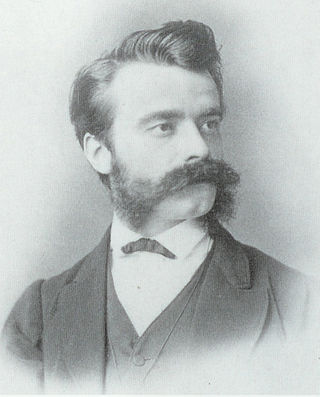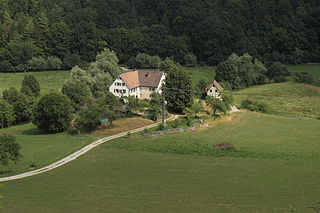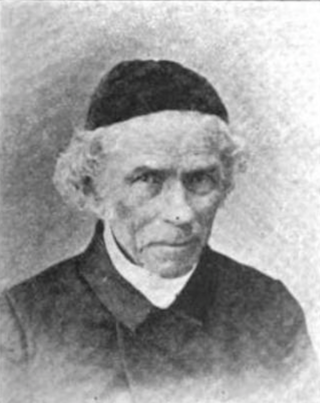
The Pegnitz is a river in Franconia in the German state of Bavaria.

Franconian Switzerland is an upland in Upper Franconia, Bavaria, Germany and a popular tourist retreat. Located between the River Pegnitz in the east and the south, the River Regnitz in the west and the River Main in the north, its relief, which reaches 600 metres in height, forms the northern part of the Franconian Jura (Frankenjura). Like several other mountainous landscapes in the German-speaking lands, e.g. Holstein Switzerland, Märkische Schweiz, or Pommersche Schweiz, Franconian Switzerland was given its name by Romantic artists and poets in the 19th century who compared the landscape to Switzerland. Franconian Switzerland is famous for its high density of traditional breweries.

The Nuremberg S-Bahn is an S-Bahn network covering the region of Nuremberg, Fürth and Erlangen which started operations in 1987 and is now integrated into the Greater Nuremberg Transport Association. The full length of the five current lines is about 277.6 kilometres.
Ralph Tegtmeier, also known as Frater V∴D∴ and Frater U∴D∴, is a German occultist, a longtime member of the Fraternitas Saturni, and co-founder of the Illuminates of Thanateros.

Wolfgang Kraushaar is a political scientist and historian. After a residency at the Hamburger Institut für Sozialforschung from the 1980s until 2015. In 2015 he continued his research at the Hamburg Foundation for the Promotion of Science and Culture also in Hamburg, Germany.

Nuremberg Funnel is a jocular description of a mechanical way of learning and teaching. On the one hand, it evokes the image of a student learning his lessons with this kind of teaching method almost without effort and on the other hand, a teacher teaching everything to even the "stupidest" pupil. It can also reference forceful teaching of someone's ideas, ideology, etc.
Landscape mythology and anthropology of landscape are terms for a field of study advocated since about 1990 by Kurt Derungs. Derungs describes the field as an interdisciplinary approach to landscape combining archaeology, ethnology and mythology.

Georg Neumark was a German poet and composer of hymns.

Robert Hartig was a German forestry scientist and mycologist. He has been called the father of forest pathology.

The Pegnesischer Blumenorden is a German literary society that was founded in Nuremberg in 1644. It is the sole Baroque literary society that remains active today. The name derived from the river Pegnitz, which flows through Nuremberg.
Aktion Arbeitsscheu Reich was a punitive campaign in Nazi Germany targeting individuals deemed as "work-shy" or "asocial." In April and June 1938, as part of the "Arbeitsscheu Reich"(work-shy Reich), more than 10,000 men were arrested as so-called "black triangle anti-social elements" and sent to concentration camps. During the so-called June-action, about 2,500 Jews who had received previous convictions for varied reasons were also targeted.

Gerhard Rühm is an Austrian author, composer and visual artist.
Andreas Borum was a German painter and lithographer who also worked in stone, and a collector.
The Elbschwanenorden was a literary association of the Baroque, founded between 1656 and 1660, dissolved in 1667. It was initiated by the poet and Protestant minister Johann Rist in Wedel and is named after the situation of the town on the lower Elbe. One of the goals was to maintain the integrity of the German language.

The burgstall of Dörnhof Castle is the site of a demolished, medieval lowland castle situated at a height of 400 m above sea level (NHN) in the vicinity of Dörnhof Farm near the village of Dörnhof, part of Gräfenberg in the county of Forchheim in the German state of Bavaria.

Johann Friedrich Wucherer was a German Lutheran pastor, theologian, author, and co-founder of the Society of Inner Missions with Wilhelm Löhe, based in Neuendettelsau.

The bombing of Nuremberg was a series of air raids carried out by allied forces of the Royal Air Force (RAF) and the United States Army Air Forces (USAAF) that caused heavy damage throughout the city from 1940 through 1945. Nuremberg was a favored point of attack for allied bombers in World War II even though it was only later included into the radius of action due to its location in the south of Germany. Because Nuremberg was a strong economic and infrastructural hub and had symbolic importance as the "City of the Nuremberg Rally" it was singled out by the Allies as an important target.

Helene von Forster was a German women's rights activist and author. She is considered the most important representative of the feminist movement's moderate "bourgeois" wing in Nuremberg.
Manfred H. Grieb what a German entrepreneur and art collector as well as the editor of the Nürnberger Künstlerlexikon.
Nikolaus Creutzburg was a German geographer.


















